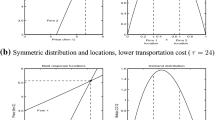Abstract
Contrary to the traditional theory of market areas which has as the central theme the firms' price changes and the demand-reactions of the widely dispersed households, our model shows the optimal solutions for the spatial use of advertising. If we assume that a central-urban located firm intends to maximize the additional net revenue by applying advertising as an instrumentvariable; we can show that the whole urban area will not be covered by the advertising campaign, but in all cases only partial areas. In this instance the optimal advertising radius will be derived from various model variants.
Similar content being viewed by others
References
Chrisholm, M.Human Geography, Harmondsworth, 1975.
Clark, C. “Urban Population Densities,”Journal of the Royal Statistical Society, 114 (1951), 490–496.
Cohen, S. B. and Applebaum, W. “Evaluation Store Site and Determining Store Rents,”Economic Geography, 36 (1960), 1–35.
Fukuchi, T. “The Double-Ring Structure Model of Metropolitan Area,” T. Fujii/R. Sato (ed.),Resource Allocation and Division of Space, Berlin, Heidelberg, New York, 1977, pp. 147–170.
Greenhut, M. L.A Theory of the Firm in Economic Space, 2nd ed., Austin, Tex., 1974.
Greenhut, M. L. and Ohta, H.Theory of Spatial Pricing and Market Areas, Durham, N.C.,1975.
Hägerstrand, T. “Aspects of the Spatial Structure of Social Communication and Diffusion of Information,”Papers of the Regional Science Association, 16 (1966), 27–42.
Kotler, P.Marketing Decision Making, A Model Building Approach, London, New York, Sydney, Toronto, 1971.
Lösch, A.Die räumliche Ordnung der Wirtschaft, 3rd ed., Stuttgart, 1962.
Mills, E. S. “Urban Density Functions,”Urban Studies, 7 (1970), 5–20.
Nordin, J. A. “Spatial Allocation of Selling Expense,” F. U. Bass and R. D. Buzell (ed.),Mathematical Models and Methods in Marketing, Homewood, Ill., 1961, pp. 173–194.
Ott, A. E. “Ein statisches Modell der Preisbildung im Einzelhandel,” Jahrbücher fur Nationalökonomie und Statistik, 172 (1960), 1–31.
Papageorgiou, G. J. “A Generalization of the Population Density Gradient Concept,”Geographical Analysis, 3 (1971), 121–127.
Papageorgiou, G. J. and Casetti, E. “Spatial Equilibrium Residential Land Values in a Multicentre Setting,”Journal of Regional Science, 10 (1971), 385–389.
Richardson, H. W. “A Note on the Dynamics of Population Density Gradients,”Annals of Regional Science, 10 (1976), 15–18.
Schöler, K.Wettbewerbsgrenzen bei monopolistischer Konkurrenz, Meisenheim/Glan, 1977.
Zentler, A. P. and Ryde, D. “An Optimum Geographical Distribution of Publicity Expenditure in a Private Organization,”Management Science, 2 (1956), 337–352.
Author information
Authors and Affiliations
Rights and permissions
About this article
Cite this article
Schöler, K. Spatial demand under advertising. Ann Reg Sci 16, 25–36 (1982). https://doi.org/10.1007/BF01287404
Received:
Revised:
Issue Date:
DOI: https://doi.org/10.1007/BF01287404




